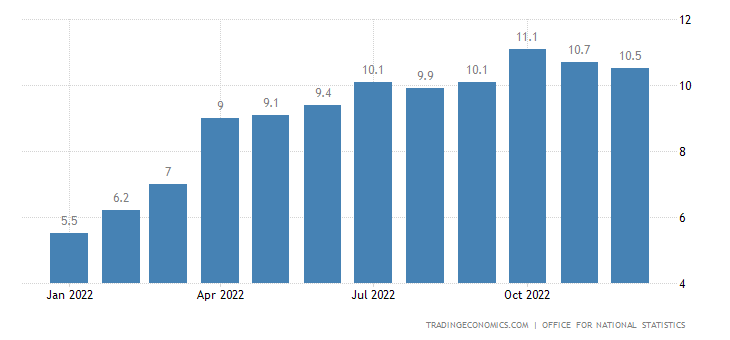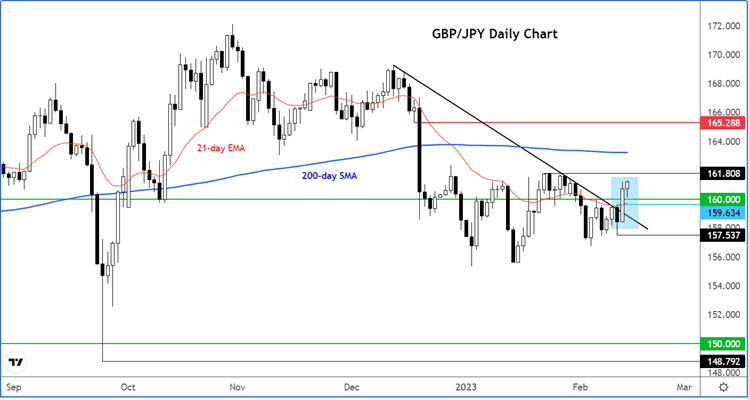
The pound will be in focus in a data-packed week, with inflation data taking center stage. It will be a particularly testing week for the GBP/USD pair as we will also have inflation data from the US today, along with a handful of other top tier macro data this week from both sides of the Atlantic to move the cable. But in this article, let’s focus on a pound cross instead to take the dollar out of the equation. The GBP/JPY comes to mind given this week’s selling of the yen, and the rebound in the pound. The latter was in demand again Tuesday morning after data revealed UK’s labour market tightened and wage pressures grew further, fuelling bets that inflation could stay higher for longer. Will that be reflected in the CPI report on Wednesday? If so, the Bank of England will have to raise interest rates even higher to prevent a wage-inflation spiral.
Tight labour market
Earlier on Tuesday, we had stronger-than-expected employment data, suggesting the UK’s labour market remains tight. The rate of unemployment remained unchanged at 3.7% in the three months to December, as employment rose by 74,000, nearly triple the rate of the previous three-month period. It looks like the labour market continued to tighten at the start of 2023, as indicated by falling applications for unemployment benefits. Jobless claims unexpectedly fell by nearly 13,000 in January, while December’s numbers were revised sharply to show a 3,200 decline instead of a 19,700-rise reported originally.
The tight labour market is putting upward pressure on wages. Annual wage inflation, excluding bonuses, jumped to 6.7% in the three months through December from the previous year, up from 6.5% in the previous month. According to figures from the CIPD, employers are planning the biggest pay rises since 2012 as they struggle to fill vacancies.
What are the expectations for UK CPI?
After first breaching 10% in June, UK CPI has remained in double digits for six consecutive months. Though in more recent months we have seen a small pullback, this has merely been a drop in the ocean. Unfortunately for UK consumers, the inflation rate is projected to remain in double digits again, with the headline print seen at 10.3% y/y compared to 10.5% the month before. So, the intense pressure on UK consumers’ pockets will continue.

The focus will also be on core inflation, which filters out more volatile energy and food prices. This is expected to have moderated a little to 6.2% annual pace from last month’s 6.3% reading.
What will inflation mean for policy?
Well, the Bank of England has now raised borrowing costs for the 10th consecutive time, although Governor Bailey has hinted that the hiking cycle might be close to an end. However, he’s also mentioned that they are concerned about the persistence of inflation, and that their future decisions will be driven, as always, by incoming data. Last week Bailey said: "We are concerned about persistence (of inflation) and that's why, frankly, we raised interest rates this time... I am very uncertain particularly about price-setting and wage-setting in this country. We have got the largest upside skew in our forecasts that we have ever had on inflation."
The hot employment and wages data certainly suggests more needs to be done to bring double-digit inflation back to the 2% target. If CPI were to remain elevated in double digits again, then this would further raise the risks that inflation is becoming entrenched. Workers have clearly been bidding up wages, and in turn companies may have to keep raising prices to cover their salary costs. So, it is possible that the tightness in the labour market will remain a key source of domestic inflationary pressure for a while. Thus, the BoE could be forced to hike rates by one or two more times before pausing.
How will GBP/JPY react?
Well, high inflation means interest rates will stay high for longer, which, everything else being equal means a stronger currency. However, when inflation is too high, this does not necessarily apply. See the Turkish lira. Okay, the pound is not the lira, but you get the point. High inflation of 10% or more increases the risks of stagflation, which can be very damaging. Elevated price pressures also squeeze consumers’ disposable income and company margins, while simultaneously increasing pressure on central banks to make growth-limiting decisions like raising interest rates. So, the positive impact of high inflation on the pound may be limited.
Technically, the GBP/JPY looks to have resumed its bullish trend after rates broke above the bearish trend line and reclaimed the broken 159.50 to 160.00 support area. This area now needs to hold on any dips to keep the bulls happy and bears at bay. From here, a retest of the 200-day average at 163.20 looks increasingly likely – assuming the upcoming inflation reports from the US and UK don’t significantly damage risk appetite.

How to trade with City Index
You can trade with City Index by following these four easy steps:
-
Open an account, or log in if you’re already a customer
• Open an account in the UK
• Open an account in Australia
• Open an account in Singapore
- Search for the company you want to trade in our award-winning platform
- Choose your position and size, and your stop and limit levels
- Place the trade
UK CPI FAQs
What is UK CPI?
UK CPI is the official Consumer Price Index for the United Kingdom. It’s published by the Office for National Statistics and used as a domestic measure of inflation using the average month-to-month price change of goods and services purchased by households.
See the latest UK CPI newsHow is CPI calculated in the UK?
CPI in the UK is calculated by tracking the price movements of 650 items – which can be goods or services – that are bought each month by the average UK household. Price changes are recorded every month and compared to the previous period. The basket is updated annually to ensure it’s representative of buying habits.
Learn more about the CPIWhat was the annual UK CPI in 2022?
The annual rate of inflation in the UK, measured by the Consumer Price Index, was 9.1% for the year. The last time UK inflation was comparable was in 1992, when inflation hit 8.4%.
Learn more about inflationWhat is the predicted UK inflation rate for 2023?
The predicted UK inflation rate for 2023 is 7.4% in 2023, compared to the CPI inflation of 9.1% for 2022, according to the Office for Budget Responsibility (OBR). The Bank of England predicts that inflation will start to fall from the middle of the year, and could be down to 4% before the new year.
Learn about the Bank of EnglandWhere will UK interest rates be in five years?
The UK interest rates in five years are difficult to predict due to the uncertainty around longer-term inflation predictions. But the Bank of England has forecast that it will raise the key interest rate to 5.2% by Q4 2023. It’s expected to ease its monetary policy to 4.7% in Q4 2024 and 4.4% by the end of 2025.
See the latest Bank of England preview




